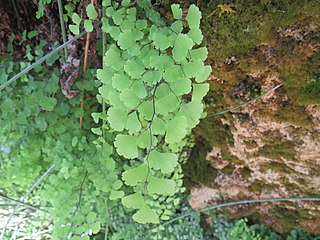
Adiantum capillus-veneris, the Southern maidenhair fern, black maidenhair fern, maidenhair fern, and venus hair fern, is a species of ferns in the genus Adiantum and the family Pteridaceae with a subcosmopolitan worldwide distribution. It is cultivated as a popular garden fern and houseplant.

Salvia viridis is an annual plant native to an area extending from the Mediterranean to the Crimea and into Iran.

Salvia spathacea, the California hummingbird sage, hummingbird sage, or pitcher sage, is a species of flowering plant in the family Lamiaceae, native to southern and central California growing from sea level to 610 m (2,001 ft). This fruity scented sage blooms in March to May with typically dark rose-lilac colored flowers. It is cultivated in gardens for its attractive flowering spikes and pleasant scent.

Acanthus mollis, commonly known as bear's breeches, sea dock, bear's foot plant, sea holly or oyster plant, is a species of plant in the family Acanthaceae and is native to the Mediterranean region. It is a leafy, clump-forming perennial herb, with a rosette of relatively large, lobed or toothed leaves, and purplish and white flowers on an erect spike.

Salvia lyrata, is a herbaceous perennial in the family Lamiaceae that is native to the United States, from Connecticut west to Missouri, and in the south from Florida west to Texas. It was described and named by Carl Linnaeus in 1753.

Spiranthes spiralis, commonly known as autumn lady's-tresses, is an orchid that grows in Europe and adjacent North Africa and Asia. It is a small grey-green plant. It forms a rosette of four to five pointed, sessile, ovate leaves about 3 cm (1.2 in) in length. In late summer an unbranched stem of about 10–15 cm (3.9–5.9 in) tall is produced with approximately four sheath-shaped leaves. The white flowers are about 5 mm (0.20 in) long and have a green spot on the lower lip. They are arranged in a helix around the upper half of the stalk. The species is listed in Appendix II of CITES as a species that is not currently threatened with extinction but that may become so. Autumn lady's-tresses are legally protected in Belgium and the Netherlands.

Centaurea gymnocarpa, also known as fiordaliso di Capraia (Italian) is a species of flowering plant in the family Asteraceae. It is a rare species endemic to Italy found only on Capraia, a small island located in the Tuscan Archipelago, with the species being distributed across 8 subpopulations on the island's surface. Its natural habitats are Mediterranean-type shrubby vegetation and rocky areas, colonizing in the cracks and fissures of cliffs.
Salvia sprucei is a herbaceous perennial in the family Lamiaceae that is native to Ecuador, growing at 7,000 feet (2,100 m) elevation or higher in thick scrub on steep slopes. It was named in 1898 by botanist John Isaac Briquet for the British plant collector Richard Spruce. It is likely that Spruce discovered the plant on a collecting trip in Ecuador in 1857.
Naufraga balearica is an extremely species of flowering plant in the family Apiaceae, and the only species in the monotypic genus Naufraga. It is endemic to the Spanish island of Majorca, where it is found only at the base of cliffs at the north of the island near Pollença. A population was discovered on Corsica in 1981, but it had died out by 1983, and it is not clear whether it arrived naturally. Its natural habitats are Mediterranean-type shrubby vegetation and rocky shores.

Salvia fruticosa, or Greek sage, is a perennial herb or sub-shrub native to the eastern Mediterranean, including Southern Italy, the Canary Islands and North Africa. It is especially abundant in Israel.
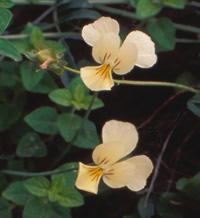
Viola ucriana is a species of plant in the Violaceae family. It is a violet that is endemic to Sicily in Italy, where its known in Italian as Viola di Ucria.
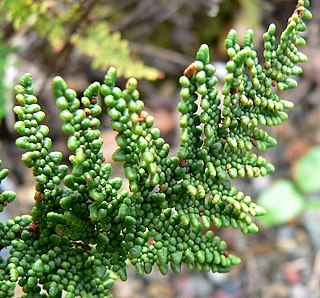
Myriopteris clevelandii, formerly known as Cheilanthes clevelandii, is a species of lip fern known by the common name Cleveland's lip fern.

Salvia caymanensis, the Cayman sage, is a short-lived perennial plant in the genus Salvia that is endemic to Grand Cayman in the Cayman Islands. It was thought to be extinct for nearly 40 years until it was rediscovered in 2007. After the damage caused by Hurricane Ivan in 2004, conservationists thought that conditions might be ideal for the reappearance of Salvia caymanensis if there was still viable seeds in the wild. A wanted poster, offering a 1000 CI$ reward, led to the discovery of the first plants seen since 1967.
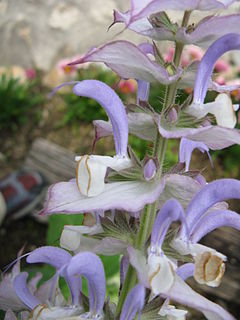
Salvia desoleana is a herbaceous perennial shrub native to the island of Sardinia in the Mediterranean. It is endemic to four or five specific locations on the island in sunny locations on limestone, granitic, and igneous rock. Salvia desoleana was named for the botanist Luigi Desole, and was first described in 1982.

Salvia hierosolymitana is a species of flowering plant in the family Lamiaceae. It is a herbaceous perennial commonly called Jerusalem salvia or Jerusalem sage that is native to the eastern Mediterranean, with populations in Cyprus, Israel, Jordan, Lebanon, Syria, and the West Bank. It typically grows in open fields, rocky soils, and among low-growing native shrubs. It was first described in 1853 by botanist Pierre Edmond Boissier, with the epithet "hierosolymitana" referring to "royal, sacred Jerusalem".
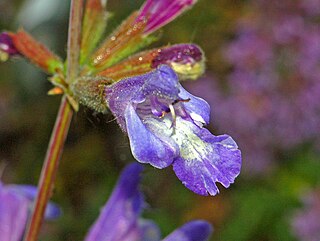
Salvia interrupta is a perennial plant belonging to the family Lamiaceae. It is native throughout the range of the Atlas Mountains in Morocco, growing between 1,300 to 1,500 ft elevation in shaded arboreal forests and on limestone slopes.

Salvia is the largest genus of plants in the sage family Lamiaceae, with nearly 1000 species of shrubs, herbaceous perennials, and annuals. Within the Lamiaceae, Salvia is part of the tribe Mentheae within the subfamily Nepetoideae. One of several genera commonly referred to as sage, it includes two widely used herbs, Salvia officinalis and Salvia rosmarinus.
Salvia merjamie is a herbaceous perennial plant that is native to the east African highlands from Ethiopia to Tanzania, and also across the Red Sea in Yemen. It grows between 6,000 and 13,000 feet elevation in grasslands, forest edges, rocky outcrops, basalt slopes, and fallow fields. The specific epithet merjamie is derived from meryamiye, the Arabian common name for the plant, which is shared with other local Salvia species such as Salvia lanigera. The Maasai common name for S. merjamie is Naingungundeu, meaning that the plant smells of rats, though the variety that is common in horticulture is named 'Mint Sauce' and is described as having a strong minty aroma. S. merjamie shares a similar distribution with Salvia nilotica, though they are not known to hybridize.
Salvia taraxacifolia is a species of flowering plant in the Lamiaceae family. It is referred to by the common name Dandelion leaved sage and is a herbaceous perennial shrub that is endemic to southwest Morocco, growing in the Atlas Mountains at elevations ranging from 2,000 feet (610 m) to 8,000 feet (2,400 m). Very adaptable, it grows on limestone slopes, forest clearings, and rocky riversides. It has no close allies in the genus Salvia. The specific epithet, taraxacifolia, is likely Persian in origin and means 'leaves shaped like a dandelion'.

The Cyprus Mediterranean forests is a terrestrial ecoregion that encompasses the island of Cyprus.
















